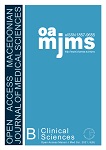The Differences of Left Lateral and Head Elevation Position toward Heart Rate of Newborns with Asphyxia in the Perinatology Room RSUD Dr. Soediran Mangun Sumarso Wonogiri
DOI:
https://doi.org/10.3889/oamjms.2021.6192Keywords:
Newborn, Asphyxia, Left lateral position, Head elevation position, Heart rateAbstract
BACKGROUND: Asphyxia delivery results in hypoxic-ischemic encephalopathy and multiorgan failure. The organ most affected by hypoxia is the cardiovascular system. Newborns with asphyxia have a lack of oxygen (hypoxia) and have an increased heart rate (tachycardia). Giving baby positions, such as supination position, pronation, right lateral, left lateral, and head elevation, are expected to improve the hemodynamic of newborns with asphyxia.
AIM: This study was to determine the difference in effect between left lateral position and the head elevation position on the heart rate of newborns with asphyxia in the perinatology room of RSUD Dr. Soediran Mangun Sumarso Wonogiri.
METHODS: This research is a quasi-experimental quantitative study with a pre- and post-test non-equivalent control group design. Sampling using non-probability sampling technique with consecutive sampling. The sample was divided into two groups, namely, the intervention group with 30 respondents who got the left lateral position and the control group with 30 respondents who got the head elevation position. Data analysis was performed using the Statistical Package for the Social Sciences parametric test with paired t-test and independent t-test.
RESULTS: The results of paired t-test analysis in the intervention group obtained p = 0.003 (p < 0.05) and in the control group obtained p < 0.001 (p < 0.05), which means that both have a significantly on changes in the heart rate of newborns with asphyxia. The results of the independent t-test analysis obtained p = 0.191 (p < 0.05), which means that there is no significant difference in the heart rate of newborns with asphyxia in the intervention and control groups.
CONCLUSION: Both interventions, giving the left lateral position and the head elevation position, have a significantly effect on changes in the heart rate of newborns with asphyxia.Downloads
Metrics
Plum Analytics Artifact Widget Block
References
Polglase GR, Ong T, Hillman NH. Cardiovascular alterations and multi organ dysfunction after birth asphyxia. Clin Perinatol., 2016;43(3):469-83. https://doi.org/10.1016/j.clp.2016.04.006 PMid:27524448 DOI: https://doi.org/10.1016/j.clp.2016.04.006
Moshiro R, Mdoe P, Perlman JM. A global view of neonatal asphyxia and resuscitation. Front Pediatr. 2019;7:489. https://doi.org/10.3389/fped.2019.00489 PMid:31850287 DOI: https://doi.org/10.3389/fped.2019.00489
Cohen G, Katz-Salamon M, Malcolm G. A key circulatory defence against asphyxia in infancy the heart of the matter! J Physiol. 2012;590(23):6157-65. https://doi.org/10.1113/jphysiol.2012.239145 PMid:23006482 DOI: https://doi.org/10.1113/jphysiol.2012.239145
Johnson PA, Schmölzer GM. Heart rate assessment during neonatal resuscitation. Healthcare. 2020;8(1):43. https://doi.org/10.3390/healthcare8010043 PMid:32102255 DOI: https://doi.org/10.3390/healthcare8010043
UNICEF, World Health Organization. World Bank: UN DESA. Levels and Trends in Child Mortality 2019. UN IGME Rep. Geneva: World Health Organization; 2019. p. 52.
World Health Organization. WHO Newborns Improving Survival and Well-being. Geneva: World Health Organization; 2020. Available from: https://www.who.int/news-room/fact-sheets/detail/newborns-reducing-mortality. [Last accessed on 2021 Feb 10]
BKKBN. Badan Pusat Statistik, Kementerian Kesehatan, and IFC International, Survei Demografi dan Kesehatan Indonesia 2017; 2017.
Jateng D. Profil Kesehatan Provinsi Jawa Tengah Tahun 2018; 2018. Available from: http://www.dinkesjatengprov.go.id. [Last accessed on 2021 Feb 10].
Konstantelos D, Gurth H, Bergert R, Ifflaender S, Rüdiger M. Positioning of term infants during delivery room routine handling analysis of videos. BMC Pediatr. 2014;14(1):33. https://doi.org/10.1186/1471-2431-14-33 PMid:24495525 DOI: https://doi.org/10.1186/1471-2431-14-33
Gouna G, Rakza T, Kuissi E, Pennaforte T, Mur S, Storme L. Positioning effects on lung function and breathing pattern in premature newborns. J Pediatr. 2013;162(6):1133-7.e1. https://doi.org/10.1016/j.jpeds.2012.11.036 PMid:23312684 DOI: https://doi.org/10.1016/j.jpeds.2012.11.036
Emery JR, Peabody JL. Head position affects intracranial pressure in newborn infants. J Pediatr. 1984;103(6):950-3. PMid:6644434 DOI: https://doi.org/10.1016/S0022-3476(83)80728-8
Vendettuoli V, Veneroni C, Zannin E, Mercadante D, Matassa P, Pedotti A, et al. Positional effects on lung mechanics of ventilated preterm infants with acute and chronic lung disease. Pediatr Pulmonol. 2015;50(8):798-804. https://doi.org/10.1002/ppul.23049 PMid:24706414 DOI: https://doi.org/10.1002/ppul.23049
Fister P, Nolimal M, Lenasi H, Klemenc M. The effect of sleeping position on heart rate variability in newborns. BMC Pediatr. 2020;20(1):156. https://doi.org/10.1186/s12887-020-02056-2 PMid:32284055 DOI: https://doi.org/10.1186/s12887-020-02056-2
Morina N, Johnson PA, O’Reilly M, Lee TF, Yaskina M, Cheung PY, et al. Doppler ultrasound for heart rate assessment in a porcine model of neonatal asphyxia. Front Pediatr. 2020;8:18. https://doi.org/10.3389/fped.2020.00018 PMid:32083045 DOI: https://doi.org/10.3389/fped.2020.00018
Borzie K, Jasper N, Southall DP, MacDonald R, Kola AA, Dolo O, et al. Monitoring intrapartum fetal heart rates by mothers in labour in two public hospitals: An initiative to improve maternal and neonatal healthcare in Liberia. BMC Pregnancy Childbirth. 2020;20(1):362. https://doi.org/10.1186/s12884-020-02921-z PMid:32536345 DOI: https://doi.org/10.1186/s12884-020-02921-z
Malusky S, Donze A. Neutral head positioning in premature infants for intraventricular hemorrhage prevention: An evidence-based review. Neonatal Netw. 2011;30(6):381-96. https://doi.org/10.1891/0730-0832.30.6.381 PMid:22052118 DOI: https://doi.org/10.1891/0730-0832.30.6.381
Kaur V, Kaur R, Saini SS. Comparison of three nursing positions for reducing gastric residuals in preterm neonates: A randomized crossover trial. Indian Pediatr. 2018;55(7):568-72. https://doi.org/10.1007/s13312-018-1298-0 PMid:30129537 DOI: https://doi.org/10.1007/s13312-018-1298-0
Rad ZA, Mojaveri MH, Hajiahmadi M, Ghanbarpour A, Mirshahi S. Effects of position on oxygen saturation and heart rate in very low birth weight neonates. Casp J Pediatr. 2016;2(2):153-7.
Downloads
Published
How to Cite
Issue
Section
Categories
License
Copyright (c) 2020 Noerma Shovie Rizqiea, Septy Nur Aini, Ratih Dwilestari Puji Utami, Ratnawati Ratnawati, Khairunisa Wardani (Author)

This work is licensed under a Creative Commons Attribution-NonCommercial 4.0 International License.
http://creativecommons.org/licenses/by-nc/4.0








